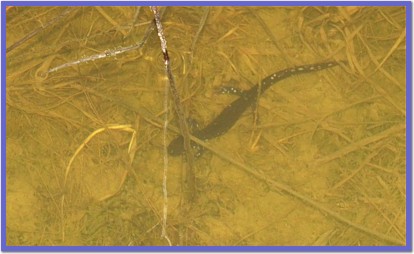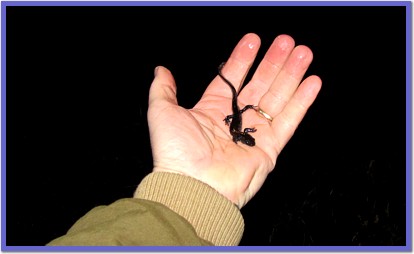
"A great northern blue-spotted what?" replied the voice on the phone.
"No, no...just blue-spotted," I answered, "Blue-spotted Salamander! I got this great, as in "really cool", Blue-spotted Salamander."
"Oh, cool", came the voice again. "So, when will the article be ready?"
"Soon as I can dig up a bit more information and get the photo's back from processing. Then it's up to you!", I countered.
The rest of the conversation consisted of our usual banter before signing off and getting back to work, but that's how a lot of articles at NatureNorth start out. I find a cool critter or get some great pictures of something, then bang out some text to go with them. Then I hand over the text and images to Tom; he works his digital wizardry on them, and presto, a new article is posted to NatureNorth!
Let me back-track a bit more and tell you about how I got the Blue-spotted Salamander in the first place. Cool critters often have cool stories to go along with them. Looking for, and finding, different critters is something I've always enjoyed. These days I just have more reasons than ever to do so. Now each cool new critter I find means one more article for NNZ, but far more importantly than that, it means another opportunity to introduce my kids to something new in nature. I never tire of the look on their faces when they experience the discovery of a new animal. So I'm forever dragging them along on trips and hikes in hopes of encountering new critters. And we are seldom disappointed.

A Blue-spotted Salamander in a shallow pond.
On that particular night things were already going greatly. We were at our cottage in the Whiteshell. It was the 3rd week of April and I'd suggested going out to do some frog monitoring, to which the response from both my boys was "Can I come, Can I come". In mid-April darkness falls, and the frogs start calling in earnest, shortly after 9:00 pm and as neither of my boys, 8 and 5 years old, ever falls asleep before 9:30, I said OK. So we all piled into the van and drove up the road from our cottage to one of the ponds that I monitor for calling frogs. As we pulled up to the pond, really just the widening of a small creek adjacent to the road, we could already here the croaking - with the van running and the windows up! I shut the van off, killed the headlights and instructed the boys to be quiet and just listen; I had to do the survey first, so no talking.
As I rolled the windows down the sound was almost overwhelming, a full chorus of spring peepers, boreal chorus frogs, wood frogs and even the occasional leopard frog, going to beat the band. After the obligatory 3-minute listen, during which my kids were actually quiet, I recorded the data, then identified the calls of each type of frog to the guys and we talked a little about why the male frogs were making all this racket.
Then it was off to another nearby pond for another listen. But on a whim I added a little side-trip, up a nearby access road to a Hydro substation, to another little pond, not much more than a ditch really, but somewhere that I'd had some luck before. In this very pond, many moons ago, long before marriage and kids, I had found Blue-spotted Salamander larvae. I knew this was about the time of year that the adult salamanders ought to be there to mate and lay eggs, so I thought, "What the heck, let's have a look".
I stopped the van again and instructed the guys to stay put, at least until I had my initial reconnaissance done. (If you really want kids to see stuff, sometimes you have to keep them under a tight rein, so they don't scare stuff away!) I grabbed my flashlight, dip net and plastic jar (the amphibian hunter's bare necessities) and picked my way over to the pond. The light beam illuminated about 1 metre of pond edge at a time. I had barely begun moving it when, "Yow! I don't believe it!" There in that circle of light was a Blue-spotted Salamander!

Got one!
I fought hard to overcome my instincts to lunge at it with the net. As I've gotten older, and better at catching stuff I might add, I've learned that slow and steady works best for catching most things. Sudden movements trigger sudden reactions in most critters. Even the bright illumination wasn't the problem, moving the light again would be. So I froze in place and slowly lowered my net into position, ...closer, ...closer, until it was only a few centimetres above the water, directly over the salamander. Then, just as it finally made a move to crawl under some leaves on the pond bottom, I scooped!
Then came the frantic examination of the net and its contents: mostly wet leaves and mud, but ... YES! There it was, shiny black and wriggling! Hoo-hoo! I had one in hand! I stuck the jar in my arm pit, so I could use my one free hand to twist the lid off, then gently plucked the salamander out of the net and plopped it into the jar. Gott'em! Then I relaxed a bit.
The excitement of "the hunt" already ebbing, I picked the flashlight up from where I'd dropped it in the midst of jarring the salamander and headed back to the van. "Oh, cool!" was the response I'd hoped for, and had gotten, on this dark spring evening.
On two subsequent nights, I added 3 more salamanders to my creel. My kids and I, and even my wife, enjoyed their company for about a month, then back they went to the same pond. We'd all learned a lot about Blue-spotted Salamanders in that time, and now you can, too.
Carry on for the Biology of the Blue-spotted Salamander!![]()
Attention all amphibian lovers!If you want to help conserve amphibians in Manitoba then get involved with the Manitoba Herps Atlas! When you find a critter enter a record to help build a province-wide database of species' locations and natural history. |

